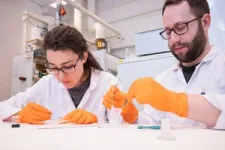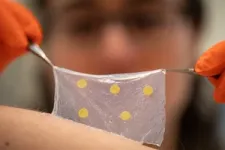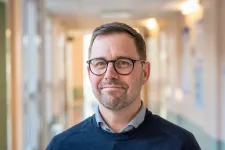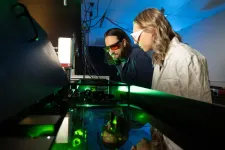(Press-News.org) Coral reefs are more than just a vital part of the ocean. They can also reveal clues about the past. Analyzing coral skeletons can paint a rich picture of the environmental history of an ecosystem, from temperature variability to land-use changes.
On the U.S. Virgin Island of St. Croix, the ruins of a Danish sugar plantation built from harvested coral bricks could be the key to understanding how and why the area was decimated by the 18th-century transatlantic slave trade.
With funding from the National Geographic Society, researchers at the Georgia Institute of Technology and the University of California, Los Angeles (UCLA) will travel to St. Croix to analyze this coral. They hope to determine how coral mining, dredging, and reef erosion affected near-shore biodiversity, contemporary coral populations, and bathymetry or underwater depth. The project uniquely combines archeology and oceanography.
“We can survey these corals to try and reconstruct the climate around St. Croix before, during, and after the slave trade — particularly with regard to sea surface temperature and trade wind strength,” said Isaiah Bolden, a co-principal investigator and assistant professor in the School of Earth and Atmospheric Sciences at Georgia Tech. “This could give us an interesting, climatically informed perspective on the timing of the transatlantic slave trade and why and how St. Croix became a part of this history.”
The Coral Codex
The first phases of the project involve collecting coral. Justin Dunnavant, co-PI, National Geographic Explorer, and assistant professor of archeology at UCLA, will use 3D photogrammetry, the process of combining photographs at different angles to create a 3D rendering, to determine which coral species were used in plantation construction. Then the researchers will collect live and historic coral samples with minimally invasive techniques so Bolden can analyze their composition.
Coral skeletons are a rich source of historical data. Like trees, living coral grows in annual rings and can be dated by counting these rings. For the dating of ancient samples, the team is also applying uranium-thorium dating, a type of radiometric dating that relies on a natural “clock” that forms as radioactive uranium locked inside of coral skeletons naturally decays into thorium.
Determining the ages of the plantation structures will help reveal whether the coral was harvested from the sea floor alive or if these buildings were constructed from preexisting coral rubble. Additional analyses can uncover clues of how the ecosystem has responded to direct human impacts from the 18th century to present. To this end, the project will also sequence proteins trapped in the skeletons of fossilized and contemporary corals on St. Croix to investigate genetic differences.
The coral skeletons can reveal more than age and genetic differences, though. Mineral “impurities” that get substituted into the growth bands of the limestone-like calcium carbonate skeleton of corals can be measured and used to infer sea surface temperature, salinity, pH, runoff, and many other environmental conditions during a coral’s lifetime.
"Corals try to build a pristine skeleton made of calcium and carbonate ions,” Bolden said. “The problem is seawater isn’t just a pure mixture of those two components, so some of this other stuff gets in the way. For example, the element strontium, which has a similar chemical behavior to calcium, is incorporated into the skeleton at a faster rate during cooler temperatures than warmer temperatures. This means we can use the ratio of strontium-to-calcium across growth bands in the coral skeleton as a clue toward past temperatures.”
Making these measurements involves drilling and dissolving powders from the coral growth bands and then using a mass spectrometer to analyze the chemical composition of the powders. The data, in turn, can be combined with instrumental records from the modern era to develop equations that translate the chemical changes into environmental changes.
“This is a really cool opportunity to study how local reefs have recorded and responded to climatic and anthropogenic changes during a definingly dark period of colonization and human civilization,” Bolden said. “How can we interface these new ecological and climate records with the written historical record to further detail the story of colonization and the slave trade in St. Croix?”
The St. Croix Ecosystem — Then and Now
The researchers will also collect contemporary data to build a better understanding of St. Croix’s existing modern coral reef ecosystems. They will collect and analyze seawater samples and conduct coral species and coverage surveys to capture current seasonal conditions and trends in reef health.
Throughout the project, the researchers will collaborate with local St. Croix universities and high schools to ensure the research isn’t just about the community, but also benefits it by giving students research opportunities.
“I'm really interested in this opportunity to bring a climate context to the history often taught in schools to discover things we haven’t learned,” Bolden said. “We’re talking about decolonizing geoscience and unearthing the stories that haven't been told.”
###
The Georgia Institute of Technology, or Georgia Tech, is one of the top public research universities in the U.S., developing leaders who advance technology and improve the human condition. The Institute offers business, computing, design, engineering, liberal arts, and sciences degrees. Its more than 45,000 undergraduate and graduate students, representing 50 states and more than 148 countries, study at the main campus in Atlanta, at campuses in France and China, and through distance and online learning. As a leading technological university, Georgia Tech is an engine of economic development for Georgia, the Southeast, and the nation, conducting more than $1 billion in research annually for government, industry, and society.
END
Using coral to unravel the history of the slave trade on St. Croix
2023-04-18
ELSE PRESS RELEASES FROM THIS DATE:
The wound dressing that can reveal infection
2023-04-18
A nanocellulose wound dressing that can reveal early signs of infection without interfering with the healing process has been developed by researchers at Linköping University, Sweden. Their study, published in Materials Today Bio, is one further step on the road to a new type of wound care.
The skin is the largest organ of the human body. A wound disrupts the normal function of the skin and can take a long time to heal, be very painful for the patient and may, in a worst case scenario, lead to death if not treated correctly. Also, hard-to-heal wounds pose a great burden on society, representing about half of all costs in out-patient care.
In traditional wound care, ...
Biomedical engineer explores new use for synthetic platelets: treating inherited bleeding disorders
2023-04-18
CLEVELAND—Even as biomedical engineer Anirban Sen Gupta refines artificial platelets to stem traumatic bleeding, he and his colleagues are seeking new uses for their synthetic solution.
The latest application to show promise involves providing synthetic platelets to treat a genetic condition that prevents blood from clotting, Von Willebrand disease (VWD). The most common of all bleeding disorders, VWD is found in up to 1% of the U.S. population (roughly 3 million people), according to the Centers for Disease Control and Prevention.
“There simply hasn’t been any study ...
Large animals travel more slowly because they can’t keep cool
2023-04-18
Whether an animal is flying, running or swimming, its traveling speed is limited by how effectively it sheds the excess heat generated by its muscles, according to a new study led by Alexander Dyer from the German Centre for Integrative Biodiversity Research (iDiv) and the Friedrich Schiller University Jena, Germany published April 18th in the open access journal PLOS Biology.
An animal’s capacity to travel is a crucial part of its survival and dictates where – and how far – it can migrate, find food and mates, and spread into new territories. This becomes even more challenging in a human-dominated world ...
Cleveland Clinic bariatric surgeon receives a 2023 Top Ten Clinical Research Achievement Award from the Clinical Research Forum
2023-04-18
Tuesday, April 18, 2023, CLEVELAND: A Cleveland Clinic landmark study on obesity and cancer, led by Ali Aminian, M.D., director of Cleveland Clinic’s Bariatric & Metabolic Institute, was recognized with a 2023 Top Ten Clinical Research Achievement Award by the Clinical Research Forum (CR Forum). The award-winning paper, the SPLENDID study that was published in JAMA, also received an additional recognition as a Distinguished Clinical Research Awardee.
The Top 10 Clinical Research Achievement Awards honor groundbreaking achievements in ...
Why do children develop type 2 diabetes? $4.1 million NIH grant will help Montefiore Einstein researchers investigate
2023-04-18
April 18, 2023—BRONX, NEW YORK – Type 2 diabetes (T2D) is surging among U.S. children. The number of youths under age 20 living with the disease has nearly doubled between 2001 and 2017, and yet—aside from increases in childhood obesity—the reasons for this disturbing increase are not clear. The National Institute of Diabetes and Digestive and Kidney Diseases (NIDDK), part of the National Institutes of Health (NIH), has awarded the Children’s Hospital at Montefiore (CHAM) and Albert Einstein College of Medicine a six-year, $4.1 million grant to ...
Cocktail of modified antibodies provides strong effect against SARS-CoV-2
2023-04-18
Is it possible to improve the antibodies that the body produces to fight SARS-CoV2? In a study led by researchers from Lund University in Sweden, this was investigated by redesigning antibodies and combining them against the virus. The modified antibodies have been tested in human cells and with mice.
Many antibodies used to treat covid infection during the pandemic have been so-called neutralizing antibodies that prevent the virus from infecting the cell. But as the virus has mutated, the ability ...
Why “born digital firms” should have a physical presence in foreign markets
2023-04-18
Firms that have their roots in selling non-physical digital products, also known as “born digital firms,” can establish an international presence without ever physically setting foot in another country. But experience shows that many born digital firms are still choosing to establish a physical presence—funded through foreign direct investments—in key markets.
A new study published in the Global Strategy Journal in February 2023 highlights the role of a physical presence in foreign markets for born digital firms. “Past research has indicated that digital technologies are highly fungible, which means that there is little relative gap in value when a resource ...
Chemists propose ultrathin material for doubling solar cell efficiency
2023-04-18
Solar power technologies, which use solar cells to convert sunlight to electricity or storable fuels, are gaining momentum in a world looking beyond fossil fuels for its energy needs.
The dark bluish solar panels that dot rooftops and open fields today are typically made from silicon, a well-tested semiconductor material. Silicon photovoltaic technology has its limitations, though, losing up to 40% of the energy it collects from sunlight in the form of heat waste. Researchers at Colorado State University are studying radical new ways to improve solar power and provide more options for the industry to explore.
CSU chemists are proposing to make solar cells using not ...
A new blueprint calls for reinvigorated global governance
2023-04-18
A Breakthrough for People and Planet: Effective and Inclusive Global Governance for Today and the Future, produced by the independent High-Level Advisory Board on Effective Multilateralism (HLAB), includes comprehensive and detailed recommendations to strengthen the global architecture for peace, security and finance, deliver just transitions for climate and digitalisation, and ensure more equity and fairness in global decision-making. It also argues that gender equality needs to be at the heart of a reinvigorated multilateral architecture along with recommendations to ensure the multilateral system is more networked, more inclusive and more effective.
Six transformational ...
Sugary drink tax improves health, lowers health care costs
2023-04-18
Oakland residents have bought fewer sugary beverages since a local “soda tax” went into effect, and that is likely improving their health and saving the city money, a new UC San Francisco study found.
According to the study publishing April 18 in PLOS Medicine, purchases of sugar-sweetened beverages (SSBs) dropped 26.8% – compared to similar cities not subject to a tax – between July 2017, when the one-cent-per-ounce tax went into effect, and Dec. 31, 2019.
The research comes a little ...







